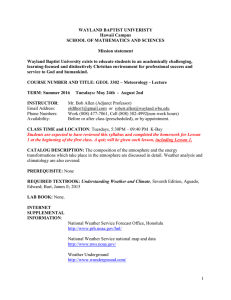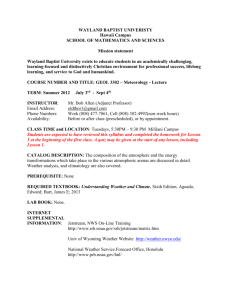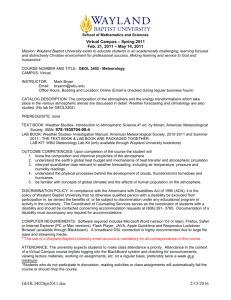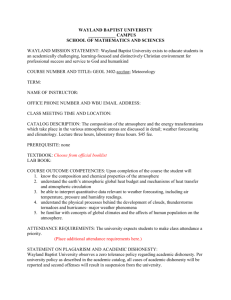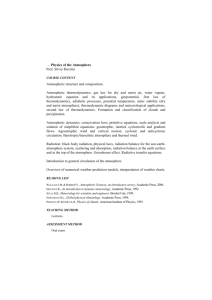WAYLAND BAPTIST UNIVERISTY Hawaii Campus SCHOOL OF MATHEMATICS AND SCIENCES
advertisement
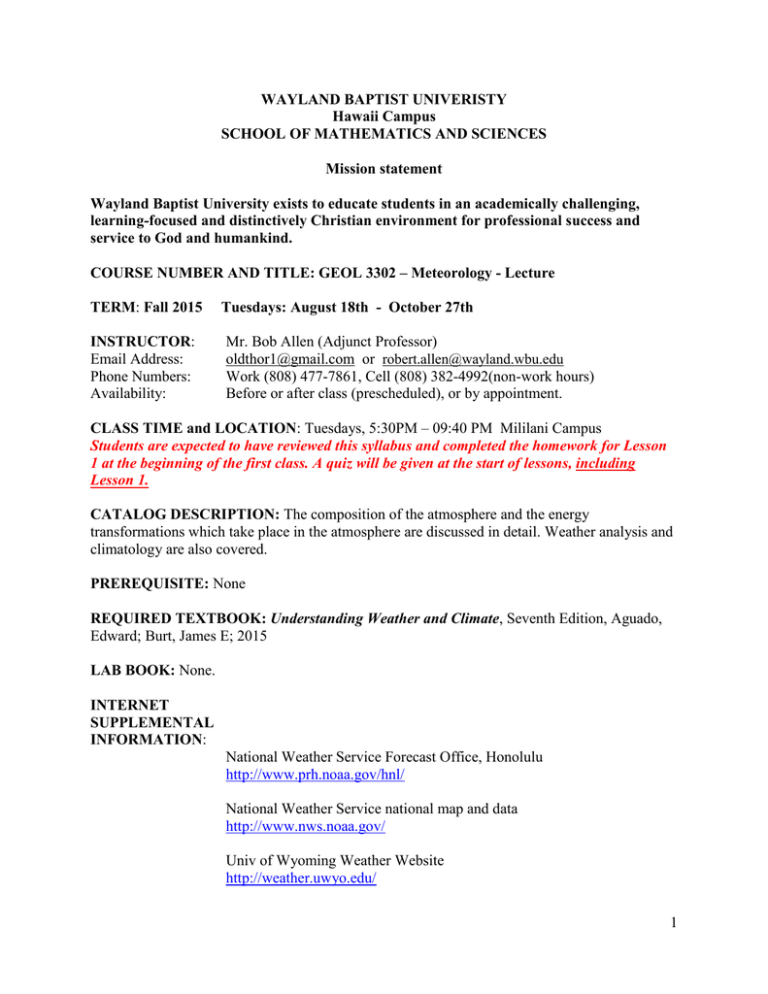
WAYLAND BAPTIST UNIVERISTY Hawaii Campus SCHOOL OF MATHEMATICS AND SCIENCES Mission statement Wayland Baptist University exists to educate students in an academically challenging, learning-focused and distinctively Christian environment for professional success and service to God and humankind. COURSE NUMBER AND TITLE: GEOL 3302 – Meteorology - Lecture TERM: Fall 2015 INSTRUCTOR: Email Address: Phone Numbers: Availability: Tuesdays: August 18th - October 27th Mr. Bob Allen (Adjunct Professor) oldthor1@gmail.com or robert.allen@wayland.wbu.edu Work (808) 477-7861, Cell (808) 382-4992(non-work hours) Before or after class (prescheduled), or by appointment. CLASS TIME and LOCATION: Tuesdays, 5:30PM – 09:40 PM Mililani Campus Students are expected to have reviewed this syllabus and completed the homework for Lesson 1 at the beginning of the first class. A quiz will be given at the start of lessons, including Lesson 1. CATALOG DESCRIPTION: The composition of the atmosphere and the energy transformations which take place in the atmosphere are discussed in detail. Weather analysis and climatology are also covered. PREREQUISITE: None REQUIRED TEXTBOOK: Understanding Weather and Climate, Seventh Edition, Aguado, Edward; Burt, James E; 2015 LAB BOOK: None. INTERNET SUPPLEMENTAL INFORMATION: National Weather Service Forecast Office, Honolulu http://www.prh.noaa.gov/hnl/ National Weather Service national map and data http://www.nws.noaa.gov/ Univ of Wyoming Weather Website http://weather.uwyo.edu/ 1 http://earth.nullschool.net/#current/wind/surface/level/orthographic=149.45,11.62,317 Jetstream, NWS On-Line Training http://www.srh.noaa.gov/srh/jetstream/matrix.htm National Oceanic and Atmospheric Administration (NOAA) Weather and Climate Sites http://www.noaa.gov/climate.html Golden Gate Weather Service (weather model forecast data) http://ggweather.com/loops/ncep_loops.htm Weather Underground http://www.wunderground.com/ COURSE OUTCOME COMPETENCIES (COURSE OBJECTIVES). The student will: 1. Know the composition and chemical properties of the atmosphere to include: a. Know the role played by CO2, methane, H2O and O3 b. Know the characteristics of the troposphere, stratosphere and ionosphere c. Layers, properties (temperature, pressure, moisture) and characteristics of the atmosphere to include ionosphere d. Gases (permanent and variable) how they vary and the role they play 2. Understand the Earth’s global heat budget and mechanisms of heat transfer and atmospheric circulation to include: a. Understand the blackbody energy curve (Fig 2.8). b. Understand the term “selective absorption”. c. Understand the concept of latent heat and specific heat capacity. d. Understand the influence of latitude, altitude, surface and terrain on temperature. e. Understand the concepts of energy and radiation, properties of the sun’s electromagnetic radiation, and how the sun’s radiation curve compares to the earth’s radiation curve f. Understand earth’s dependence on its annual orbit around the sun in determining the earth’s energy balance, how and why the amount of energy from the sun varies by latitude, time of the year and from locale to locale and understand how this variability causes of the earth’s annual seasons. g. Understand how excesses and deficits in thermal energy are redistributed and how the earth’s circulation pattern, both in the atmosphere and the ocean, contribute to the heat transfer and balance. h. Understand the processes that go on in the earth’s atmosphere that affect energy coming from the sun and energy being radiated by the earth—in short the earth’s energy balance system. i. Be able to draw the location of the major High and Low Pressure Systems in the northern and southern hemispheres that drive the earth’s atmospheric circulation and ocean currents and the general surface wind patterns associated with them. 2 j. Describe variabilities in temperature on the local, regional, continental and global scale, the affect of ocean and land on the variability and how/why temperatures vary from day to night. 3. Interpret data relevant to weather analysis, including air temperature, pressure, and humidity readings to include: a. Understand the following terms, their importance and how they are measured: temperature, pressure, humidity, wind, visibility. b. Understand the role of pressure (both horizontal and vertical) in determining wind. c. Be able to draw the general surface wind patterns associated with High and Low Pressure Systems in the northern and southern hemispheres throughout the world. d. Understand the concept of Coriolis Force and what causes it. e. Explain the concept of fronts and air masses and how they are recognized and depicted on weather charts. f. Be able to look at surface and upper air data and recognize pressure patterns (Highs, Lows, Jetstreams, frontal systems) g. Be able to draw the direction of winds around High and Low pressure systems in the northern and southern hemisphere h. Understand the concept of global and local wind patterns and how they affect weather i. Recognize various scales of weather phenomena and relate them to observed weather elements 4. Understand the physical processes behind the development of clouds, thunderstorms, tornadoes, and hurricanes to include: a. Be able to explain the concept of atmospheric stability. b. Be able to explain the role of water vapor in stability and cloud formation, and the role of latent heat and changes of state in water between gas (vapor), liquid (water) and solid (ice). c. Understand lifting processes in the atmosphere and how they affect air parcels; understand the changes in temperature, pressure and humidity that occurs when air is lifted d. Describe the three stages in the life cycle of a thunderstorm and characteristics associated with each stage 5. Be familiar with concepts of global climates and the affects of human populations on the atmosphere. a. Understand the major climate controls on the earth’s weather (influence of land and oceans, location and winds associated with semi-permanent High and Low pressure systems worldwide). b. Recognize that shifts in the normal ocean and atmospheric patterns can affect weather patterns around the globe (example, El Niño and La Niña). c. Understand the nature of the earth’s energy balance and recognize factors that can alter the balance and drive changes in the climate 3 ATTENDANCE REQUIREMENTS: The University expects students to make class preparation and attendance a priority and attend all classes. If you have any reason to suspect you might miss more than two classes, you should strongly consider taking the class at a different time. WBU Undergraduate Policy states that any student who misses 25 percent or more of the regularly scheduled class meetings may receive a grade of F in the course. If a student is unable to attend a class, it is the responsibility of that student to notify the instructor immediately and to acquire the notes from another student for the class(es) missed. Attendance will be taken and will be factored into students' evaluations. Tardies and/or early departures will also count towards an individual’s attendance record. If you miss class, notify the instructor (preferably via e-mail) of your status and reason for missing class. If a student misses a class, they are responsible for turning the homework assignment in to the instructor at the start of the next class. No exceptions. All Wayland students are expected to attend every class meeting; the minimum percentage of class participation required to avoid receiving a grade of “F” in the class is 75%. Students who miss the first two class meetings without providing a written explanation to the instructor will be automatically dropped from the roster as a “no-show.” Students who know in advance that they will be absent the first two class meetings and who wish to remain in the class must inform the instructor in order to discuss possible arrangements for making up absences. Although this class is an elective with no pre-requisites, this is a 3000-series science class and past students have had difficulty catching up with the work and maintaining satisfactory grades if they missed more than two classes. DISABILITY STATEMENT: “In compliance with the Americans with Disabilities Act of 1990 (ADA), it is the policy of Wayland Baptist University that no otherwise qualified person with a disability be excluded from participation in, be denied the benefits of, or be subject to discrimination under any educational program or activity in the university. The Coordinator of Counseling Services serves as the coordinator of students with a disability and should be contacted concerning accommodation requests at (806) 291- 3765. Documentation of a disability must accompany any request for accommodations.” COURSE REQUIREMENTS and GRADING: Students will be evaluated on the basis of a mid-term exam, a term project, nightly quiz/attendance/participation, and a final exam. Note: You must have a valid reason for missing an exam. Missed exams must be made up within 2 days. Consult with the instructor immediately (preferably before the fact) should you require a make-up date for an exam. 4 A. Grading Scale A 100-90 B 89-80 C 79-70 D 69-60 F below 60 I incomplete* W withdrawal * A grade of incomplete is changed if the deficiency is made up by midterm of the next regular semester; otherwise, it becomes an "F". This grade is given only if circumstances beyond the students' control prevented completion of work during the semester enrolled and attendance requirements have been met. B. Computation of Final Grade Mid-Term Exam (Week of Lesson 6) 30 % Class Participation (Includes quizzes) 15 % Term Project (Due start of class of Lesson 8)15 % Final Exam (Week of Lesson 11) 40 % Students shall have protection through orderly procedures against prejudices or capricious academic evaluation. A student who believes that he or she has not been held to realistic academic standards, just evaluation procedures, or appropriate grading, may appeal the final grade given in the course by using the student grade appeal process described in the Academic Catalog. Appeals may not be made for advanced placement examinations or course bypass examinations. Appeals are limited to the final course grade, which may be upheld, raised, or lowered at any stage of the appeal process. Any recommendation to lower a course grade must be submitted through the Executive Vice President/Provost to the Faculty Assembly Grade Appeals Committee for review and approval. The Faculty Assembly Grade Appeals Committee may instruct that the course grade be upheld, raised, or lowered to a more proper evaluation. COURSE SCHEDULE AND ASSIGNMENTS NOTE: In support of Course Outcome Competencies, especially Competency #3, each class will begin with a review of current weather and observations, and what students have observed, and questioned, regarding local weather occurrences especially on Oahu. Week/Lsn 1 2 Subject and Homework (Aug 18th ) Introduction/Atmospheric Structure and Composition Homework: Read Chapter 1, Review Questions 5 - 8, 13 - 15, 18, 24 - 25. (Aug 25th ) Heating the atmosphere and the Seasons Homework: Read Chapter 2, Review Questions 2, 5, 7, 9, 11, 12, and 15. 5 3 (Sept 1st ) Energy Balance and Air temperature Homework: Read Chapter 3, Review Questions 1, 2, 4, 8, 10, 11, 13, 14, 16, 18, and 20. 4 (Sept 8th ) Atmosphere Moisture Homework: Read Chapter 5, Review Questions 1, 8 – 13, 20, 24. 5 (Sept 15th) Cloud Development and Forms Homework: Read Chapter 6, Review Questions 1, 2, 7 - 10, 15, 16 6 (Sept 22nd) Mid Term Exam (material from Lessons 1 through 5) Lightning, Thunder and Tornadoes; Stability Read Chapter 11, page 314 – 334, Review Questions 2, 6, 8, 9, 12, 16. 7 (Sept 29th) Precipitation, Sensors, Weather Networks Homework: Read Chapter 7, Review Questions 1, 5, 8 - 10. 8 (Oct 6th) Atmospheric Pressure and winds Homework: Read Chapter 4, Review Questions 1, 3, 4, 16, and 17. Critical Thinking: Question 1. Project is due at start of class. 9 (Oct 13th) Atmospheric Circulation: Global and Local Wind Patterns Homework: Read Chapter 8, Review Questions 1, 4, 7, 10, 18, and 22. Critical Thinking Question 9. 10 (Oct 20th) Air Masses & Fronts/ Mid-Latitude Cyclones Homework: Read Chapter 9, Review Questions 1, 2, 5, 7, and 8. Homework: Read Chapter 10 pages 289-293 and 302-304; Review Question 2. 11 (Oct 27th) Final Exam (material from Lesson 6 through 10) Check On-Line Course on WBU Blackboard Twice a Week Students should log into the course on Blackboard before the first lesson and check Blackboard at least two nights a week for announcements and supplemental information/data to ensure they are prepared for the next class. Homework Assignment and Lesson Reading Homework and lesson reading assignments are to be completed before the start of class for which they are assigned. For example, reading and homework questions associated with Lesson 1 are to be completed before the night of Lesson 1 class and are part of preparation for the Lesson 1 class. This ensures students are prepared to participate orally and at the blackboard and take test/quizzes. Power Point slides presented in class will be posted on the Blackboard under the respective lesson number before that lesson is presented, generally by the preceding Saturday morning. Students should review those slides as part of class and test preparation. 6
